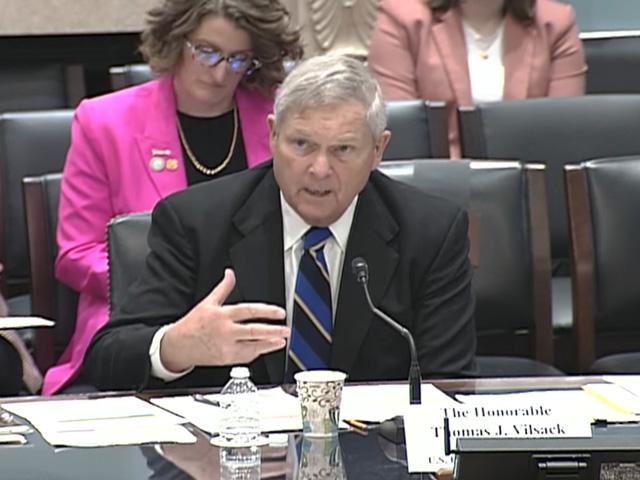House Ag Hearing With Ag Secretary
Amid an Array of Issues, Some Lawmakers Have Disaster Aid Concerns
OMAHA, (DTN) -- Republican Lawmakers on the House Agriculture Committee raised concerns Tuesday with USDA requesting tax information from producers to get disaster aid under Phase II of the Emergency Relief Program.
Agriculture Secretary Tom Vilsack countered that lawmakers may hear complaints from farmers about 2022 disaster payments because of less money than in prior years. Lawmakers also wanted suggestions from the secretary about how to craft a disaster program in the next farm bill that would not require Congress to pass an ad-hoc disaster bill every couple of years.
Vilsack testified in a marathon session with nearly 50 members of the House either diving into their own monologues or asking the secretary repeatedly about food assistance, climate-smart programs, USDA assistance for meatpackers, Chinese ownership of U.S. farmland, food imports, BSE in Brazil, Mexico's biotech corn ban, tick infestations and buzzards that kill cattle.
For farmers, at least one repeated theme was the focus on disaster aid. GOP lawmakers don't like USDA using tax returns for the Emergency Relief Program (ERP) Phase II.
Rep. Frank Lucas, R-Okla., asked about the differences between ERP Phase I and Phase II and how USDA is distributing aid under ERP Phase II.
Under ERP Phase I, the Farm Service Agency moved away from reported crop insurance losses to financial losses based on tax year, including using income tax data. Lucas said the change in the program has led to farmers in Oklahoma telling him they are not eligible for relief under ERP Phase II.
Some of the problems of farmers missing out on disaster payments stem from the threshold Congress set for losses to qualify for disaster aid, Vilsack said.
"People are bumping up against the 70%, but they don't meet the 70% threshold," he said.
USDA also created the revenue-directed ERP to help smaller producers who also might not have crop insurance or use the Noninsured Crop Disaster Assistance Program (NAP). Another issue the secretary highlighted is that Congress provided $10 billion in aid for disasters in 2020 and 2021, but $3 billion in aid for 2022 losses.
"I would just simply point out you're going to get a lot of complaints" over 2023 payments, he said. Vilsack added, "We're going to be faced with a serious disconnect between the level of help and the amount of money that's available to us."
P[L1] D[0x0] M[300x250] OOP[F] ADUNIT[] T[]
The lessons learned from ERP Phase I and II will also dictate how USDA administers the program for the 2022 disasters.
Rep. Ronny Jackson, R-Texas, said the change in the ERP has led to wheat farmers in his district who had crop losses in early 2022 still waiting for assistance compared to those who received payments for losses in late 2021. Jackson said the process used for ERP Phase II "has become too burdensome or complicated for farmers and the FSA agency that are responsible for providing assistance with those issues."
Jackson said he also had heard complaints from producers about tax information being required for assistance under ERP Phase II.
Vilsack also reiterated that ERP Phase II is meant to help "small or very small producers who have never accessed any of these programs because they don't have crop insurance." That's the main reason USDA is requiring tax records from those producers because they do not have other information on file with USDA.
"So, there's an element of agriculture that doesn't get benefits under these traditional disaster assistance efforts," Vilsack said.
For those producers who do not have crop insurance, "How do you establish the loss?" Vilsack said. "One way you establish it is whether or not your income has been significantly impacted."
Jackson said the request for IRS records, along with the Inflation Reduction Act (IRA) funds to hire up to 87,000 IRS agents, "is just making people in my district a little bit nervous."
Once ERP Phase II is done, USDA will see if there are additional funds remaining that can go back and provide aid to those who initially did not qualify for ERP in either phase.
Multiple times during Tuesday's hearing, Vilsack also held up a printout of USDA disaster programs for representatives.
Interest continues in having a permanent disaster program.
Rep. David Rouzer, R-N.C., asked Vilsack about the potential of a permanent disaster program in the farm bill, given that it often takes Congress multiple years before they will pass an ad-hoc program for agriculture.
"Cash flow is critically important to producers," Rouzer said. "I personally am in favor of some sort of at least initial payment once a disaster hits without having to wait for Congress."
Beyond crop insurance, Vilsack said other programs are important, especially for the livestock sector. Vilsack said flexibility is needed in a disaster program given regional differences in extreme weather events.
"So, the degree to which you can provide flexibility to meet the moment, I think that would be very important," Vilsack said.
Rep. Salud Carbajal, D-Calif., pointed to the challenges his producers are now facing, shifting from drought conditions to floods this year. Currently, though, the ERP is preparing to help farmers with 2022 disasters. A similar program for 2023 would also need congressional funding. There are also often challenges providing aid to specialty crop producers.
"There has been growing frustration with growers of specialty crops about their inability to receive disaster relief support," Carbajal said.
Pointing back to funding differences from one year to the next, Vilsack said this is another challenge Congress faces with ad-hoc programs.
"So, people's expectations are they are going to get a certain amount, and they're obviously going to be surprised when that amount is significantly less than it was for disasters two years ago," he said.
Chris Clayton can be reached at Chris.Clayton@dtn.com
Follow him on Twitter @ChrisClaytonDTN
(c) Copyright 2023 DTN, LLC. All rights reserved.




